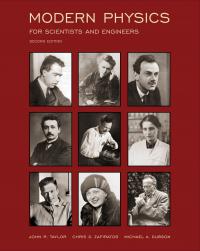Modern Physics
Modern Physics
By: John R. Taylor, Chris D. Zafiratos, Michael A. Dubson
This book is a readable and comprehensive account of the physics that has developed over the last hundred years and led to today’s ubiquitous technology. The authors lead the reader through relativity, quantum mechanics, and the most important applications of both of these fascinating theories.
For all sales outside of the United States, please contact Felicity Henson, fhenson@aip.org
Title information
With more than 100 years of combined teaching experience and PhDs in particle, nuclear, and condensed-matter physics, these three authors could hardly be better qualified to write this introduction to modern physics. They have combined their award-winning teaching skills with their experience writing best-selling textbooks to produce a readable and comprehensive account of the physics that has developed over the last hundred years and led to today’s ubiquitous technology. Assuming the knowledge of a typical freshman course in classical physics, they lead the reader through relativity, quantum mechanics, and the most important applications of both of these fascinating theories.
PART 1. Relativity
CHAPTER 1 The Space and Time of Relativity
CHAPTER 2 Relativistic Mechanics
PART 2. Quantum Mechanics
CHAPTER 3 Atoms
CHAPTER 4 Quantization of Light
CHAPTER 5 Quantization of Atomic Energy Levels
CHAPTER 6 Matter Waves
CHAPTER 7 The Schrödinger Equation in One Dimension
CHAPTER 8 The Three-Dimensional Schrödinger Equation
CHAPTER 9 Electron Spin
CHAPTER 10 Multielectron Atoms; the Pauli Principle and Periodic Table
CHAPTER 11 Atomic Transitions and Radiation
PART 3. Systems with Two or More Atoms
CHAPTER 12 Molecules
CHAPTER 13 Solids – Theory
CHAPTER 14 Solids – Applications
CHAPTER 15 Statistical Mechanics
PART 4. Subatomic Physics
CHAPTER 16 The Structure of Atomic Nuclei
CHAPTER 17 Radioactivity and Nuclear Reactions
CHAPTER 18 Elementary Particles
APPENDIX A Physical Constants
APPENDIX B Useful Mathematical Relations
APPENDIX C Alphabetical Lists of the Elements
APPENDIX D Atomic and Nuclear Data
Suggestions for Further Reading
Picture Credits and References
Answers to Odd-Numbered Problems
Index
John R. Taylor
John R. Taylor is Emeritus Professor of Physics and Presidential Teaching Scholar at the University of Colorado at Boulder. He received his B.A. in mathematics from Cambridge University and his Ph.D. in physics from the University of California at Berkeley. In 1966, he joined the faculty at Colorado, where his research interests include quantum scattering theory and the foundations of quantum theory. Professor Taylor has won numerous teaching awards, served as Associate Editor of the American Journal of Physics, received an Emmy Award for his television series called “Physics 4 Fun,” and given “Mr. Wizard” lectures to some 40,000 school children throughout Colorado. He has written three internationally best-selling textbooks, including the landmark Classical Mechanics, Introduction to Error Analysis, and Modern Physics for Scientists and Engineers.
Chris D. Zafiratos
Chris Zafiratos received his B.S. from Lewis & Clark College in 1957 and his Ph.D. from the University of Washington in 1962. He was then a postdoctoral fellow at Los Alamos National laboratory and faculty member at Oregon State University before coming to the University of Colorado in 1967. His principal research was in nuclear physics, and he was author of over fifty articles and books. He received the Distinguished Alumni Award from Lewis & Clark College, as well as numerous other citations for contributions to his field. He was a fellow of the American Physical Society and served in several academic administrative positions during his tenure at the University of Colorado. He was also vice president emeritus for the University of Colorado System, which includes four campuses, as well as professor emeritus of physics. Chris died in August in the year 2004.
Michael A. Dubson
Michael Dubson is a Senior Instructor in the Physics Department at the University of Colorado at Boulder, where he is Associate Chair for Undergraduate Studies and a member of the Physics Education Research group. He received his B.S. from the University of Illinois (class of 1978) and his Ph.D. from Cornell University (1984). For ten years, he worked as a condensed matter experimentalist, doing research at Ohio State and Michigan State Universities, and winning an NSF Presidential Young Investigator Award. In 1995, he switched careers and joined the faculty at Boulder, where he has worked on innovative teaching methods and undergraduate curriculum development. He is the winner of several teaching awards, including the 2006 American Association of Physics Teachers Award for Excellence in Undergraduate Education. He is also a software developer for PhET (http://phet.colorado.edu), a suite of free, interactive simulations for learning science. His (non-physics) interests include amateur astronomy, French literature, and biking with his wife Gisele.

